Space Marine hands on preview
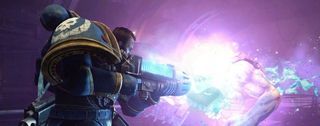
"Of course, that's not the only race you'll be fighting. As well as Orks, you'll also be facing off against the forces of Chaos.” Involuntarily, I hear myself quietly say a word. It is “yay.”
I cough quickly, trying to mask my slip but I think it's too late. A few guys in the room turn to look at me. I've just admitted I have engaged in the dark art of Warhammer 40,000 to a room full of people I've never met. In most places, this is social suicide. I meet their gaze, and every single one is smiling. “Yay!” they say back.
I'm excited because – as much as I love Games Workshop's sci-fi opera of manly men beating up Orks, the green mushroom-men lack the sustained threat that would drag me through a campaign of third-person violence against them. Chaos have that threat in bucket-loads: one of their gods sits on a throne of skulls. Another was made from too many orgies. They're the epitome of 40K evil, and as a foe, they make 40K fans say things like “yay!”
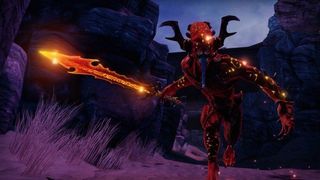
We're in a safe place. Sitting in this room in Vancouver, home city of Space Marine developers Relic, we can talk about 40K without lowering our voices or obsessively checking behind our shoulders for girls. Later on, I speak to Matthew Berger, Space Marine's singleplayer campaign designer. I've got a short time to interview Matthew about his game – four vignettes of which I've just played – but like all 40K players, both lapsed and active, first we have to exchange our details.
“Who did you collect?” Matthew asks. I tell him I was always an Eldar guy. “My first army was Orks. Then Chaos Daemons, now I'm working on a Dark Eldar force.” A pause, then a nod. That short blurt of sound, verbal static to anyone not acquainted with Games Workshop's sci-fi universe, and we've seen deep into each others' nerdy souls.
I glance outside, onto Vancouver's snowy streets. People shuffle past. Normal people. These people wouldn't know a Tyranid Carnifex if it came up and bit them on the face, and Carnifexes – with their four attacks and strength of nine – are likely to do just that. Yet Space Marine is consciously targeting a wider audience than Relic's lovingly detailed Dawn of War games: how will they communicate 40,000 years of history and little plastic men to people who just want to shoot shit? In two ways. The first is to avoid too much duplicitous intrigue, and dodge the underlying subtext of 40K – that Space Marines are technically cruel fascists among the stars. Here, Ultramarine Captain Titus is a morally superb hero, making him easy to get behind. The second solution is simpler: by having a lot of shit to shoot.

Throngs of meat
PC Gamer Newsletter
Sign up to get the best content of the week, and great gaming deals, as picked by the editors.
The Space Marine is always outnumbered. In 40K's gloriously gruesome artwork, and in the tabletop battles themselves, the hyper-men inside the power armour seem to thrive on having throngs of meat around them into which they can insert bullets, chainsaws, and special axes that go “whirner- ner.” Space Marine makes this clear right out of the gate.
Despite the Chaos reveal, my first interactions in the game are with Orks. Space Marine is set on the Forge World of Gaia. An aside for non-geeks: Forge Worlds are giant, globe-wide factories, producing the machines necessary for the Imperium of Man's constant, grinding war effort. Gaia's specific remit is Titans. They're the biggest of the big in a big universe that engages in a war so big it eclipses all else. But there's a problem.
The problem is green and likes to eat people. The Ork invasion of Gaia has brought the planet to a standstill, halting Titan production and buggering up operations in other parts of space. To break the deadlock, a chapter of Space Marines is en route, but they're taking their sweet time. Enter Ultramarine captain Titus and his band of blue-armoured buddies – dropping down planetside to fry a few mushrooms. (That line only works if you know Orks are technically sentient mushrooms. Non-geeks, you may laugh now.)

Space Marine's Orks aren't clever, but they are numerous. Rolling into one of Relic's prepared fights, I was quickly mobbed. The combat is two-tone: both melee and ranged attacks have their specific applications, and can be near-instantly flipped between. At this early stage in development, I was reduced to using a gamepad. The ranged toggle sits up on the left trigger. Holding it down sends Titus into a familiar third-person shooter view, the camera tugging close to his shoulder. But I was more interested in Space Marine's close-quarter battles. Once I was sufficiently encircled by a snarling ring of green, I picked a direction and started cleaving my way out.
The first Ork I swung my chainsword into fell back, clutching a stump. A second took his place in the circle, only to find four foot of whirring death embedded in his shoulder. As I hammered the X button to continue the four-stage combo, my Titus yanked his sword from Ork numbertwo's torso, leaving him collapsed on his friend's armless corpse.
I was still wildly outnumbered. Gretchen had joined the fray. Shorter than Orks by a few feet, they're little more than cannon fodder in the 40K universe: here they were little more than globs of blood on the wind, the final slice of my chainsword disintegrating one of the overenthusiastic creatures who'd dared to step into my range.
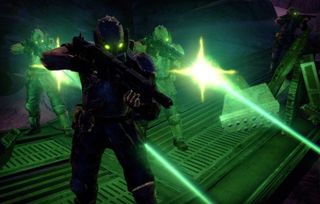
Bolt action
When I turned back, the ring of Orks around me had turned into a queue. I brought up my bolter pistol and took aim, squeezing off five, six shots, popping five, six heads. The bolter itself is a standard machinegun, but – like everything in 40K – beefed up to king-size and decorated with more skulls than a goth's pencilcase. The pistol version trades rate of fire for accuracy; I was assured the heavy version – which I didn't get to see but appears in the game occasionally – is a monster, trading nothing for jesuschrist- look-at-the-blood.
As one of 40K's stupidest species, Orks don't need to have particularly complex AI routines. Most threw themselves on my chainsword. Some, though, were a little brighter, and forced a change in tactics. Nobs are the biggest Orks, and always your primary concern in a fight. The standard chainsword attack isn't enough to break through their armour, which forces you to use Titus's heavy melee swing.
At present, there's not enough fluidity between the two core melee skills: I would have liked to chain crushing sword swings into lighter sweeps, then back again, but the prealpha version I was playing didn't allow it. That being said, a previous build had a kick built into Titus' repertoire that may well worm its way back into future versions, making for smoother and more reflexive fights.
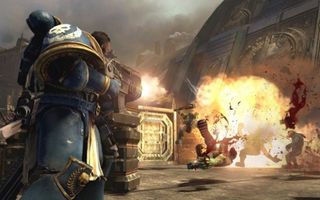
The Orks are joined on the planet by Chaos forces, let loose into the material world by the insalubrious research the previous inhabitants of the planet were involved in. That means mad, hooded cultists, lightning fast bloodletter daemons, and toughest of all, your dark mirror image: Chaos Space Marines. My Ork battles were generally fun: the simple formula of cleave, shoot, cleave more remained satisfying with repetition. I had less fun against Chaos's tougher foes.
Chaos theory
During a battle in a valley, I was jumped by Bloodletters. Thanks to their connection with the warp, they could phase quickly about the battlefield, dodging my swings and – worse – delivering some of their own without retaliation. Titus's simple control scheme is a blessing when surrounded, but without any specific combos or any way to knock the daemons off their attack patterns, I was repeatedly eviscerated. The only way past the section was to stand farther back and take potshots: an approach at odds with the developer's exhortation that “Space Marines don't take cover.”
That means no cover system, even if Gaia looks like it was previously inhabited by a race of sentient three-foot-high walls. Despite the developers' best efforts, it's tough to break routine: I repeatedly found myself running to hide when close to death. Space Marines use a recharging health bar, with a layer of armour protecting a layer of hit points. But when attacks start to chip away at the underlying health bar, instead of finding one of the game's abundant low walls and surreptitiously ducking your seven foot frame behind it, Relic want players to hurl themselves back into the action and earn their survival.
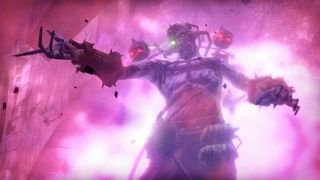
This is done with executions: long, slow animations cribbed from Dawn of War's 'sync kills' (think a Dreadnought squishing the guts out of a Tyranid). A successful execution – throwing an Ork to the floor and stamping on his head, or bisecting him with a chainsword – nets you health points, as well as 'fury'. Save up enough of this and you can either slow time to pick off long range enemies, or unleash a vast sword sweep that pops anyone in a forward arc.
These fury kills are the embodiment of 40K's rampant imagination. They're what I dreamt was happening when I played the tabletop game, what players across the world dream about when they dab paints all over small figurines.
In trying to bring Space Marine to an audience scared of dice, they might lose some of the nuance and depth of 40,000 years of war – but if any developer knows, respects, and loves Warhammer 40K, it's Relic.
Most Popular

